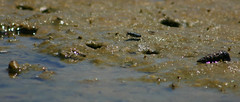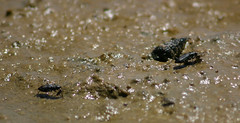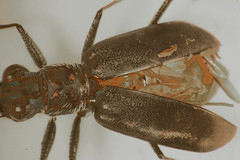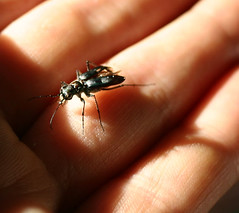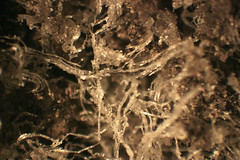A enclave of C.h.hemorrhagica has developed in an area that had none that I could find in 2003. There are probably over a hundred in an area of 1 meter by 18 meters. They are sharing this space with about 50 sand wasps (Bembix comata). These tigers like to go to the water's edge and catch the little bugs and flies that run near on the muddy salty water.
Saturday, July 30, 2005
false-color-Hemorrhagica
This is Cicindela hemorrhagica hemorrhagica. He is very small for his species. This false color image shows that he not only has torn connections to his left outer wing, which causes it to stick out, but he also has damage to the right side of his elytra and flight wings. If you look to the top outer wing covering, there is a gash. This is a typical 'cut' from a tiger beetle. Many times tigers flip their prey over and make a slice in their abdomen. If the insect (or other arthropod) is a strong fighter then the tiger may go for what ever is available.
I found this tiger yesterday running near a spot where tigers were not reported. He was in an area where leaf cutter bees were stocking their individual hives (holes in the ground) in the sand. This tiger had been in a fight - most probably with a larger more aggressive tiger and could not fly. I caught him with my hand and put him in a glassine bag - as I always do. In a short time, I noticed a tiger with a red abdomen running under my feet... Some how this little spunky guy wiggled his way out of his container jumped out of my breast pocket and was trying to get away through the salicornia.
His red abdomen gave him away. He bit me through out his confrontation. What a great little fighter he is!
I found this tiger yesterday running near a spot where tigers were not reported. He was in an area where leaf cutter bees were stocking their individual hives (holes in the ground) in the sand. This tiger had been in a fight - most probably with a larger more aggressive tiger and could not fly. I caught him with my hand and put him in a glassine bag - as I always do. In a short time, I noticed a tiger with a red abdomen running under my feet... Some how this little spunky guy wiggled his way out of his container jumped out of my breast pocket and was trying to get away through the salicornia.
His red abdomen gave him away. He bit me through out his confrontation. What a great little fighter he is!
Hemorrhagica-hand
Here is what C.h.hemorrhagica real color looks like. He is calmer now, and has eaten some cat food and bit the soil in his aquaria for water. This specimen has no markings on his elytra and is a stealy black. Beautiful!
Friday, July 29, 2005
Cicindela trifasciata sigmoidea

In 2003 I hunted for tigers all around Mugu. I only found a few of these beauties. They were wonderful and as mated couples (in the aquaria), they shared food (kills). Today, I found many many of them on the mudflats and in areas I found without any tigers in 2003 . There were also many many larvae burrows, too. I was concerned for their population because of the heavy rains this last winter. But, it seems they are doing well and so are their favorite food - beach bugs and sand flies.
Two of these golden beauties were brought home and fed cat food and house flies.
YUM!
Tuesday, July 26, 2005
salt-crystals
If the silty soils of Mugu estuary are let to dry, a tangle of salt crystals grow between the matrix of the grains and particles and excrude super fine hairs. The sharp but flexable needles criss-cross throughout the drying mud.
This photo shows salt crystals and grains of soil (they are the dark areas completely surrounded by the salt) amplified 20x under a disecting microscope.
This photo shows salt crystals and grains of soil (they are the dark areas completely surrounded by the salt) amplified 20x under a disecting microscope.
Miniblues
salted soils

There is something special about soils in an estuary. This salt panne, is roughly 3 X 5 meters square - if it were compacted. But, this salt panne is, at the most, 3/4 meters wide (some parts are wider but have islands of vegetation which splits the panne into two segments 1/3 meters wide) and it meanders maybe another 10 meters.
This soil is very fine. At high tide water covers the panne, and when it retreats, the upper portion of the soil compacts and splits to a depth of about a centimeter. As the panne continues to dry salt crystals form on the surface and within the matrix of soil. Patches of the top layers cut into many sided shapes, curl at the edges as more of the moisture evaporates.
Cicindella hemorrhagica

My first day out to think about the up coming survey, I decided to look for C. hemorrhagica. This lively tiger beetle is gray black with markings near the end of its eyltra. As you approach it, it takes off flashing its red abdomen hidden beneith its wings. I found C. hemorrhagica a tiger with great spunk.
This small panne at Mugu has many larvae holes. This is good news. Seven beetles were counted and averaged flying past as I walked the panne three times.
Monday, July 25, 2005
Insect Abundance of Mugu Lagoon and the San Gabriel Mountian and River
This week begins a study of the insects of two very different environments. One, a mudflat and tidal wetland, the other a very complex mountain river. The insect abundance study will follow another group of studies concurrently going on at the same time in both watersheds adding terrestrial insects and spiders to perhaps reveal changes through the habitats by altitude, water availability, and disturbance by human beings.
This blog will have dates and images of sites and notes/entries and any changes to the traps. It will also have information for those who wish to help in the Mountian collection...
I am looking forward to this season's collection.
terry
This blog will have dates and images of sites and notes/entries and any changes to the traps. It will also have information for those who wish to help in the Mountian collection...
I am looking forward to this season's collection.
terry
Tuesday, July 05, 2005
light through the mist

Water from this year's rain still hovers over the mountains in the morning as mists... What is a hundred year storm? It is a storm that rarely happens except once every hundred years. Now it is offical, 2005 rained more than the storm recorded over a hundred years ago.
From the Los Angeles Times: July 5, 2005..
"A gauge closer to the 1883-84 measuring site puts total at .14 of an inch over the old record. ... It's not official, but we may have set a new seasonal rainfall record in downtown Los Angeles after all."
Subscribe to:
Posts (Atom)
